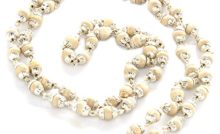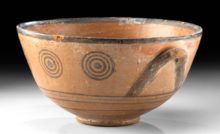Savannah River


There has always been debate among Indian artifact collectors about whether some chipped relics are knives or projectile points. The well known Savannah River is certainly one of these debated items. Were these artifacts used as spear points or knives or both? The word “point” will be used here for ease of reading.
The Savannah River point was given that moniker by William H. Claffin from examples discovered on Stalling Island in the Savannah River and named for this large river system that divides the states of South Carolina and Georgia. Almost countless authors have expressed written opinions about this artifact type and if this writer showed all known references, the listing would be much longer than the article. The Savannah River point is usually described as a medium to large point/knife with straight to convex blade sides and a short and wide stem that may be concave or straight on the basal edge. That description seems simple enough to be able to identify these relatively common artifacts. But it gets more complicated. Exactly how big is medium to large? Unbroken examples have been found that measure from a much re-sharpened (and probably anciently discarded) one inch in length to a whopping eight plus inches long. That is a considerable size variation. Probably the average of most found examples would be medium size or in the two to three inches ranges though four and five inches examples are certainly not extremely rare. The description of the blade edges being straight to convex is usually correct. Many large examples feature straight and parallel blade sides for the first half or so of length from the shoulders and then curve in to meet at the distil end or point. Some start an outward arc beginning at the shoulders and continue curving to the tip while others are simple straight sided stemmed triangles or have slightly concave blade edges. Generally the greater the point length and or width, the more the blade sides curve outward with the smaller artifacts seeming to have more straight edges which was most likely caused by ancient re-chipping to acquire a keen cutting edge. The shoulders of this artifact type can be sharply angled or rounded but most were probably made with reasonably sharp shoulders and have become more rounded with re-sharpening. And what about the stem? Normally the Savannah River stems are straight and short and broad with an equal number having straight and concave basal edges. But many examples have been found with narrow stems, with broad contracting stems or with slightly convex bases. Now this is getting complicated! To add to the typology confusion, there are other named artifacts found in the Piedmont which are similar to this point. The Kirk Stemmed type can be mistaken for the Savannah River as can the Stanly and Morrow Mountain types. And on much re-sharpened examples, the shoulders can almost disappear and the artifacts can be confused with the lanceolate Guilford points. How do you differentiate? Well, some of the time you simply cannot and have to make a logical name choice.
The Savannah River type point is a very widely distributed type being found on the east coast states from Florida to New York and westward to Ohio and south into Mississippi and Louisiana, though in some of these regions the point may have a name other than Savannah River. In the Carolinas and Virginia, it is found from the coast to the mountains where it may be identified by such names such as Kays, Appalachian or Benton. The Savannah River point is dated as being used during the Late Archaic to Early Woodland Periods, circa 3,000 BC to 500 BC, which would make them spear or lance points since the bow and arrow are only about 1500 years old in this part of the world. In the Piedmont, the prehistoric natives used a multitude of local stones to make this point type including silicified shale, quartz, quartzite, jasper, chalcedony and rhyolite but examples have been found that are made of chert, basalt, schist and argillite to name a few. You will note that flint is not included in this listing because that mineral does not naturally occur in this region. By far the majority of Piedmont Savannah River points were made of rhyolite, quartzite and quartz. This point type is often associated with steatite bowls, so if you find soapstone bowl fragments or sherds and stemmed points on the same site, you are probably finding Savannah River points.
Now we know the description and age of the Savannah River points and the lithic materials used to make them but what is the answer to the original question. Are they points or knives? Since prehistoric American Indians had no steel or iron tools, they had to make do with what was available. They needed to cut and carve and scrape and dissect both plants and animals as well as to make war on their enemies. There was plenty of stone available which was flaked into needed and usable sharp tool shapes. These tools became the original “Swiss Army Knives” and the natives could perform almost endless tasks with them. Today we call these tools Clovis and Hardaway and Kirk and, of course, Savannah River. So the Savannah River artifacts were both projectile points and knives and many other tool forms. It was a multipurpose tool in their single purpose lives – that purpose being survival. The Savannah River was a unique tool invention to the prehistoric natives and today we can find the remains of their inventiveness in this artifact – the somewhat enigmatic and definitely collectible Savannah River.
REFERENCES:
Chaffin, William H.
“The Stallings Island Mound, Columbia Co, GA”, PAPERS OF THE PEABODY
MUSUEM OF AMERICAN ARCHAEOLOGY AND ETHNOLOGY
1931
Coe, Joffre L.
“Formative Cultures of the Carolina Piedmont”,
TRANSACTIONS OF THE AMERICAN PHILISOPHICAL SOCIETY
1964
Hranicky, Wm. Jack
MIDDLE ATLANTIC PROJECTILE TYPOLOGY AND NOMENCLATURE
1994
Perino, Gregory
SELECTED PREFORMS, POINTS AND KNIVES
OF THE NORTH AMERICAN INDIANS, VOL. 1
1985
Copyright © 2013, Ji
Recent Posts
Anculosa
It’s What was for Dinner There are 650 species of river snails in North America…
A Saw Tooth Rim Bowl
Most Indian artifact surface collectors in the Piedmont of the Carolinas and Virginia are familiar…
A Square Stem Collared Pipe
The natives in late prehistoric and early historic North America made and used many kinds…
A Sauratown Copper Celt
The Indian village, known as Upper Sauratown, in Stokes County, NC, was lived in for…
The Saura Indians of Rockingham & Stokes Counties, NC
During years of AD 1669 and 1670, the German physician and explorer John Lederer, traversed…
The Ancient Tripodal Bottles
You readers, who are in my somewhat elderly age group, will probably remember playing outside…

